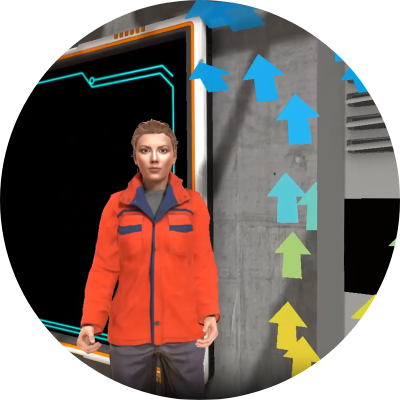 Loading...
Loading...
Initial language selection is based on your web browser preferences.

11MB
Free
Learn how the refrigeration cycle works and troubleshoot core HVAC tasks in this VR simulation. Based on the Modern Refrigeration and Air Conditioning textbook, the experience helps students understand how cooling systems operate and what to do when things go wrong. It's ideal for learners preparing for technical careers or vocational training. Students join a virtual instructor at a monorail station and become trainee HVAC technicians. In two practical lessons, they explore key system components, observe physical processes like evaporation and condensation, and investigate common air conditioning faults. Throughout the experience, they apply problem-solving skills, make observations, and build confidence with technical language and concepts. **Key Features:** - Aligned to Modern Refrigeration and Air Conditioning - Covers refrigeration principles, evaporation and condensation - Builds confidence with system knowledge and fault diagnosis ## Course Content: This course is one module, split into two lessons: - Lesson 1: Refrigeration Cycle - Lesson 2: Troubleshooting ## Duration & Guidance: Each lesson is approximately 10-15 minutes in duration, but times may vary depending on the user. Lessons can be completed across multiple sessions, as user progress will be saved. We recommend that this experience is best undertaken standing, although a seated experience is possible. ## Module 1: Refrigeration Cycle{.objective .objective1} **Lesson 1: Refrigeration Cycle** Follow a technician at a monorail station to learn how cooling systems work. Explore the main components of the refrigeration cycle and discover how they move heat away from indoor spaces. ## Learning Objectives: - Describe the components of the refrigeration cycle{.info} - Explain the basic processes within the refrigeration cycle{.info} **Lesson 2: Troubleshooting** Examine a faulty air conditioning system and use clues to determine any issues. Learn to match faults with common problems and understand how technicians make decisions on the job. ## Learning Objectives: - Name at least three possible causes of a malfunctioning AC system{.info} - Infer likely causes of a malfunctioning AC system based on a set of symptoms{.info} # TEACHING FRAMEWORK{.objective .objective} # Before the Experience **KWL Chart** Activate prior knowledge and prepare students for what they will see in VR simulation. Students will fill in the K (What I Know) and W (What I Want to Know) sections, while the remaining section will be completed post-experience. - Identify three things that you already know or think you know about the industry, technology, tools used and/or careers.{.task} - Write two questions about what you want answered or are curious about.{.task} # During the Experience **Tech Lab Journal** To support engagement and learning during each VR session, ask students to maintain a Tech Lab Journal. This journal can be a small notebook, a stapled packet, a digital document or use the worksheet provided (see exemplar for further guidance). The Vocational Pathways Worksheet Exemplar draws on the Welding and Intro to Construction simulations as detailed case studies. While these examples focus on specific experiences, the model student responses are representative of reflections, observations, vocabulary and presentations expected across all of the Vocational Pathways content. After completing each VR session, students should take a few minutes to reflect and add to their journal, noting the date and which lesson they completed. Other suggested journal entries may include: - Key Vocabulary – Identify new terms and/or technical language that was introduced, along with definitions for each. - Sketches or Diagrams – Create simple sketches of tools, systems, processes, and/or machines students interacted with, along with labels for the whole and its parts. - Notice and Wonder – Take note of interesting moments or surprising results students noticed, as well as any questions they are curious about. These should be written as “I noticed...” and “I wonder ...” statements. # After the Experience **KWL Chart** To follow up, ask students to complete the L (What I Learned) section, reflecting on what they learned during the session. - Identify at least three things that you learned about the industry, technology, concepts or career.{.task} # Extended Learning **Job Quest: Explore an Entry-Level Career Role** Students are then encouraged to continue their learning by researching what an entry-level position in this career field looks like. This exploration makes learning more personal and purposeful, helping students consider future career opportunities. Even if they decide this career is not a good fit, the process builds career awareness, critical thinking, and allows the student to take ownership of their learning. Ask students to research the following: - Job Description - Tools and Skills Needed - Education and/or Training Needed - Salary and Job Outlook - Work Environment Ask students to create a visual summary of their research. Consider giving them a choice to create a slide presentation, one-pager, infographic, short video, or use another appropriate presentation method. # Reflection Ask students to write a reflection. Based on their VR experience and research, would they consider this career? Why or why not? For full set-up instructions, including video walkthroughs and support documents, please visit our support pages [ClassVR Support](https://www.classvr.com/)